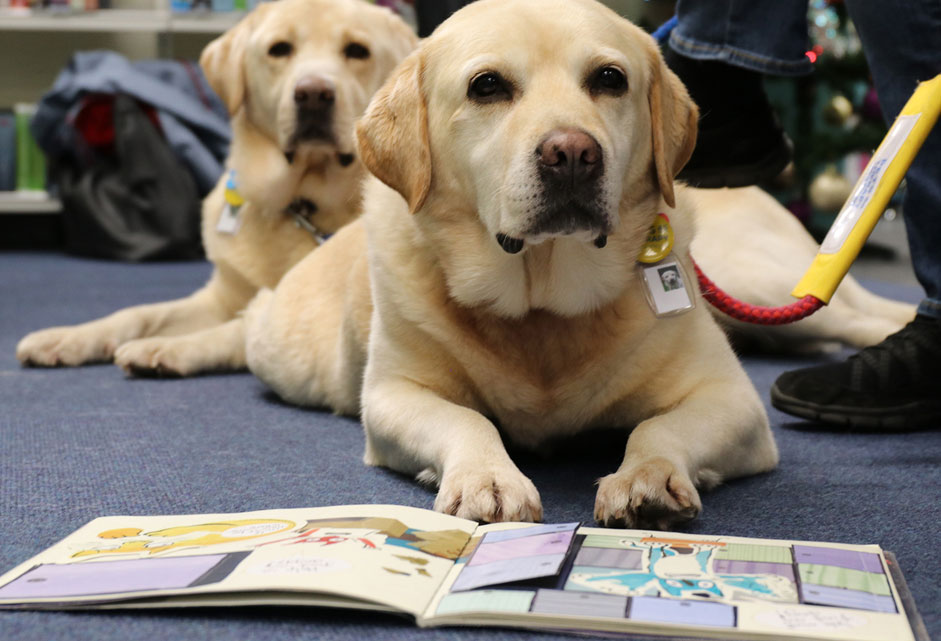The idea of reading to a dog originated in America. Alison Tutill had seen some research carried out by BookTrust and thought it would be something we could offer in libraries.
Introduction
Libraries are all about reading for pleasure and what greater pleasure than a dog with a book? The scheme allows the child to relax and enjoy a book without being corrected. Dogs are non-judgmental. 'Read2Dogs initially started before the pandemic to encourage reading and sharing books with dogs. It is known that the pandemic has impacted on children’s language and social development, so when we restarted the scheme we encouraged discussion around picture books as well as or instead of reading
The challenge
- to understand how the scheme would be implemented
- to find the dogs who were able to take part
- create a risk assessment and permission forms for anyone attending
- low literacy levels in some schools in North Yorkshire
- promote the idea to schools and families within the library
- getting families into the library to use the service
- encouraging the families to join the library and borrow books.
The solution
The solution to finding the dogs to take part was literally right place at the right time. I happened to be in Selby Library when a member of the Paws for Pals group came in to ask if we would display a poster for their dog show. I asked if there were any members of the group who would be interested in the Read2Dogs scheme, and I was put in touch with Pets as Therapy who found two volunteers and their dogs in the area.
After completing risk assessments, other official paperwork and reading the handbook, we invited a local school into the library to meet the dogs, Dora and Morgan. I hoped that the school visit would create enthusiasm for the scheme when the children went home and told their families about the visit. Schools in the area also emailed parents and put it on their social media. We used the school visit to launch the service and started taking bookings for Saturday morning visits. The sharing of books with the dogs would be in fifteen-minute slots. This allowed the child to get comfortable with Dora or Morgan. There is a beanbag for them to sit on at the side of the dogs. They would then share the book for 10 minutes and there would be time at the end to swap over and the next child to get comfortable.
We encouraged the families to come in earlier than their allotted time to enable browsing the books and picking out something they would like to share.
We had all ages coming to read or meet the dogs, such as a 22-year-old man with learning difficulties whose mum wanted him to come to meet the dogs and interact with someone. He came every time and started to form words. We had a six year old child who wouldn’t interact with other children who had her mum in tears because she chose a book and quite happily went and sat down with Morgan.
Unfortunately, COVID-19 arrived. The library had to close, and all activities had to cease. August 2021 came, and we were able to relaunch the scheme but with a difference. During COVID research had shown that children had been losing their language skills, so we decided to not only offer the chance to read to the dogs, but also to choose a picture book and just talk about it. This would encourage children who were not able to read to attend. Even children who could read were encouraged to talk about the book if they wanted to.
We are now offering 15-minute slots on the first and third Saturday of the month.
The impact
Children in the area are visiting on a regular basis, reading to the dogs and then borrowing books and joining other schemes or events the library has to offer.
Schools in the area have contacted me to ask about the scheme and for details of how to set something up in their schools. One school contacted me because a pupil had gone into school and was so enthusiastic about the time she had spent in the library the previous Saturday.
A mother whose daughter has selective mutism said that her daughter had never read to anyone other than close family at home. At first, she settled down next to the dog and started whispering to him as she read. The longer she stroked him the more relaxed she became and by the end of the book, she was reading aloud.
How is the new approach being sustained
At the second launch, there was also some interest from adults, especially from a lady with a disability and a teenager with learning disabilities. We encourage anyone who would like to sit with the dogs for 15 minutes to come and join us. We invited a Pets as Therapy dog to a reminiscence session in the library. It encouraged the group to talk and reminisce.
We have recently been approached by a high school in the area asking if they can visit the library, check out the resources and have the therapy dogs there to meet the students.
Another library in North Yorkshire has recently started Read2Dogs
Lessons learned
Having the therapy dogs in on a Saturday morning is a great way of encouraging families into the library, encouraging greater footfall, more book borrowing and proving the library is a safe non-judgmental space for everyone.
Reading to dogs has been proven to help children develop literacy skills and build confidence, through both the calming effect of the dog’s presence and the fact that the dog will appear to be listening to the child read without being judgemental or critical. When reading aloud to a dog, the children begin to listen to themselves and remember what they’ve been taught.

